Plantagenet England Plantagenet period is often used as

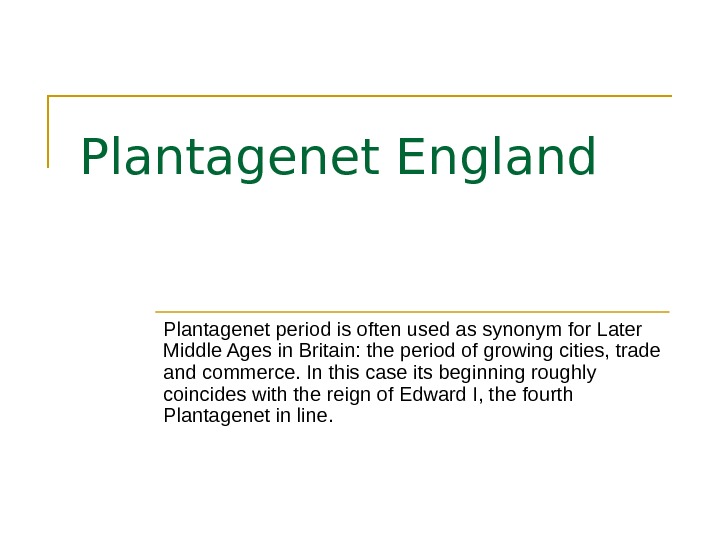






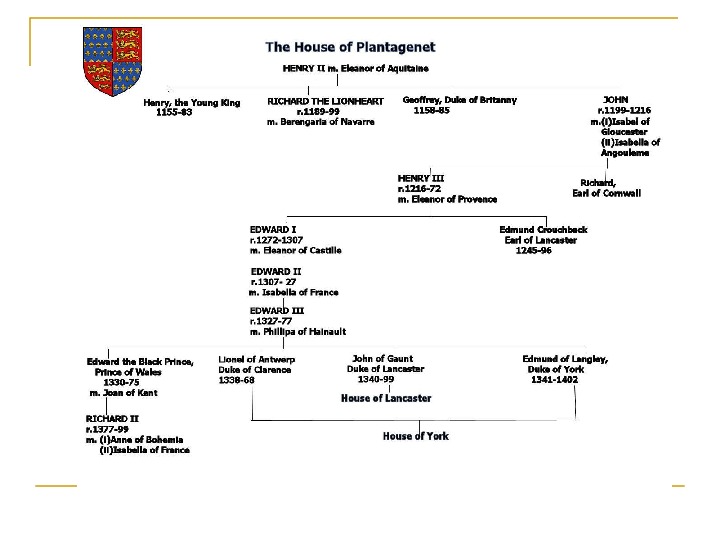
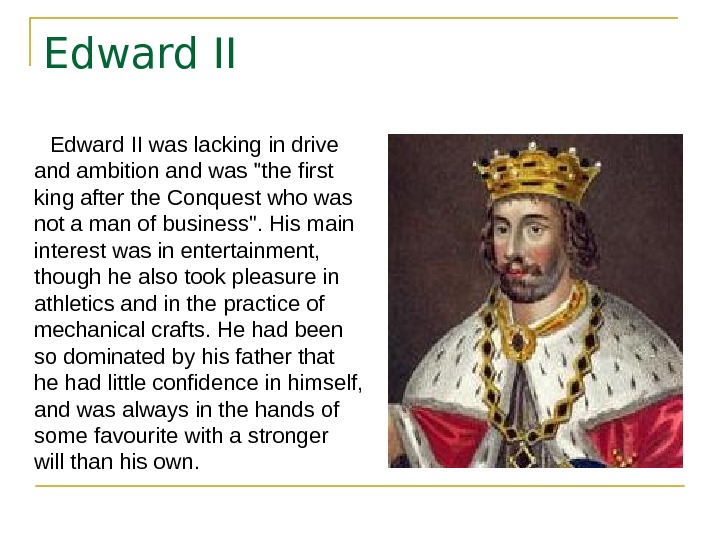





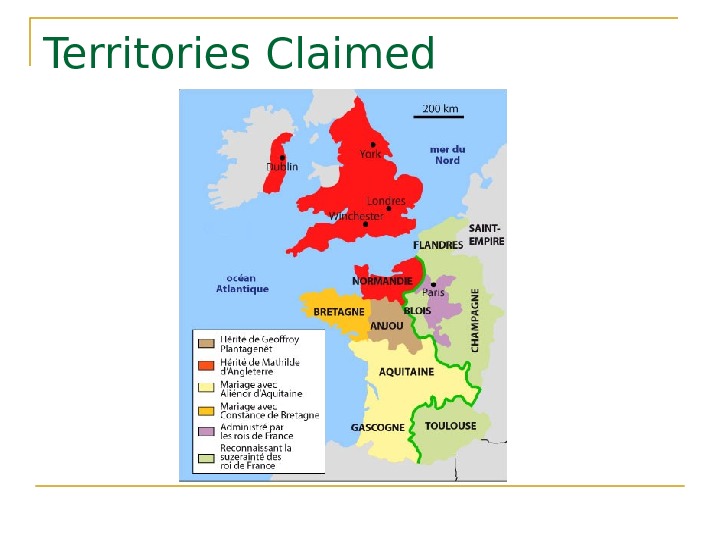
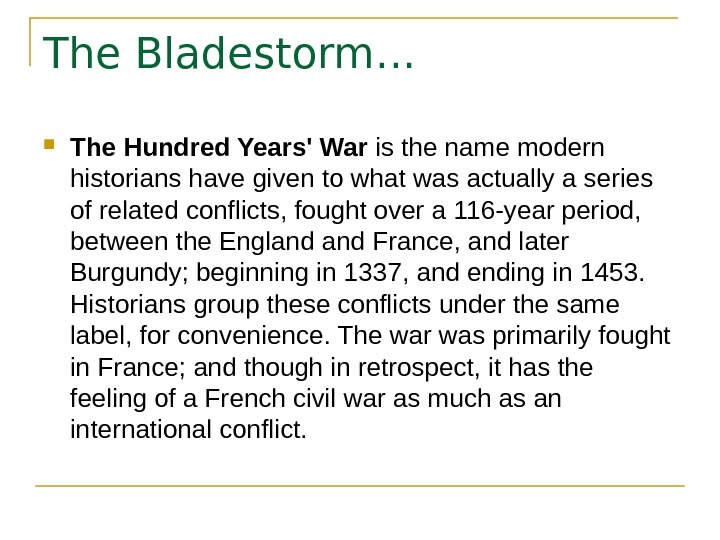
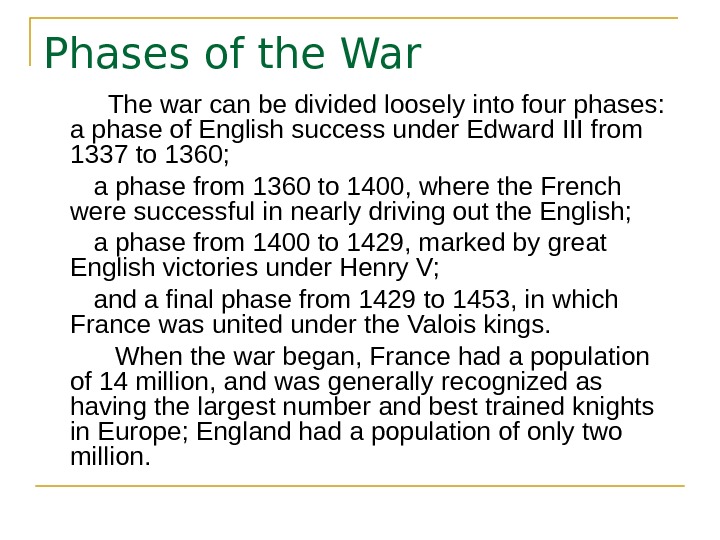

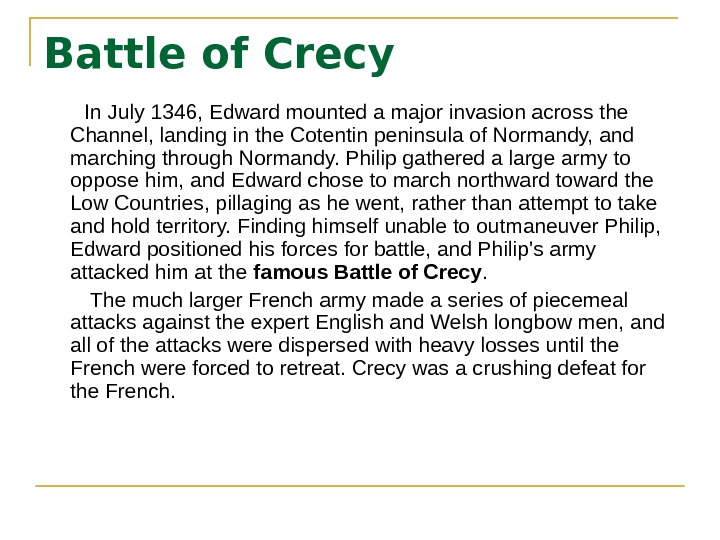
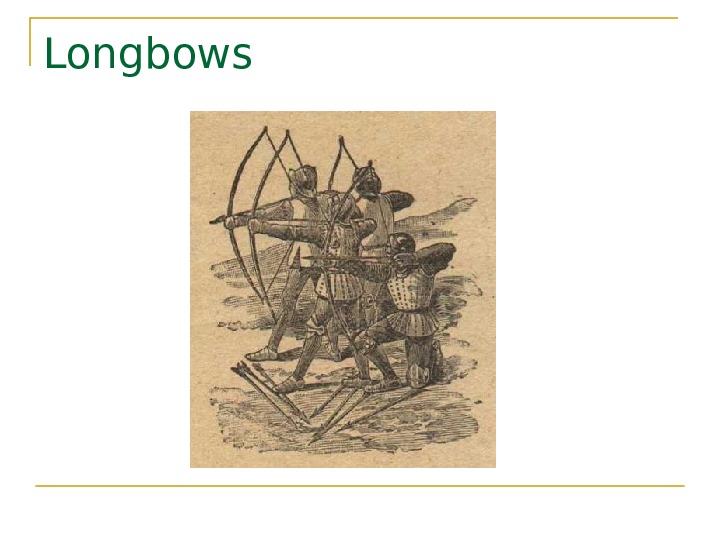
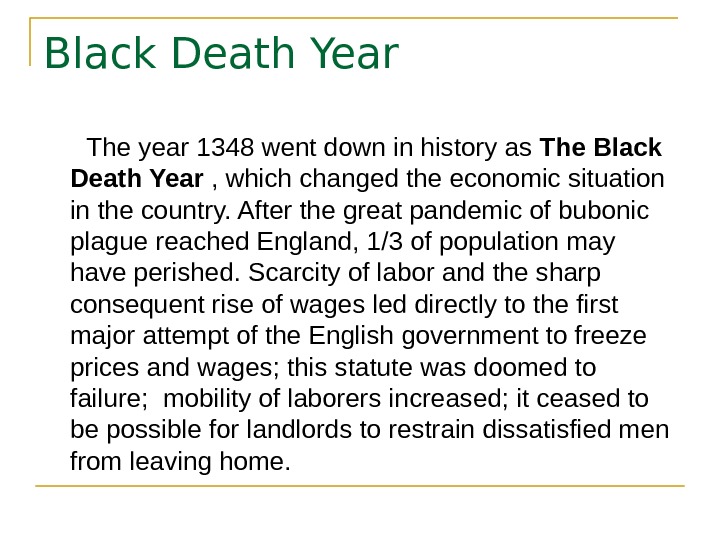

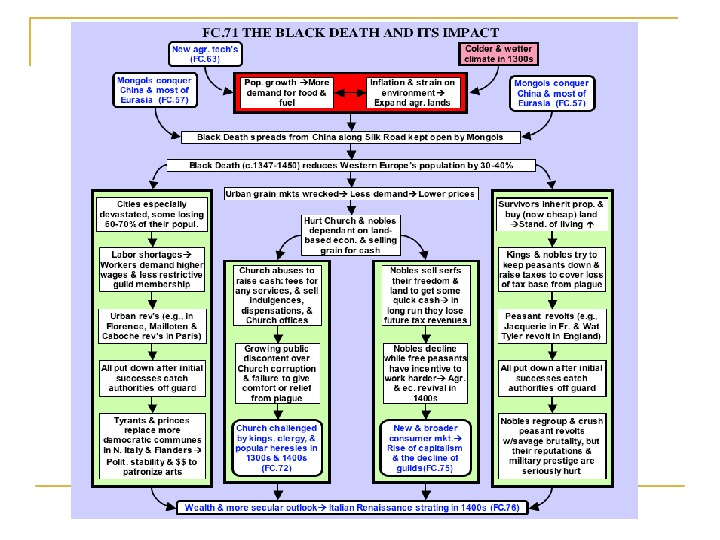



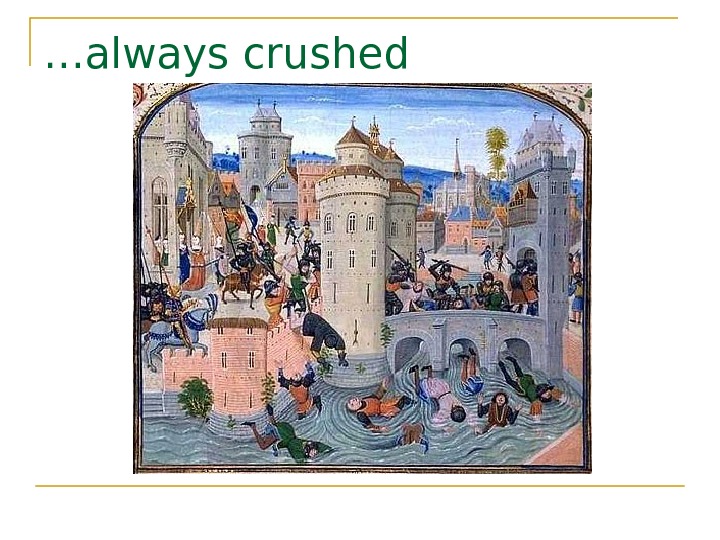

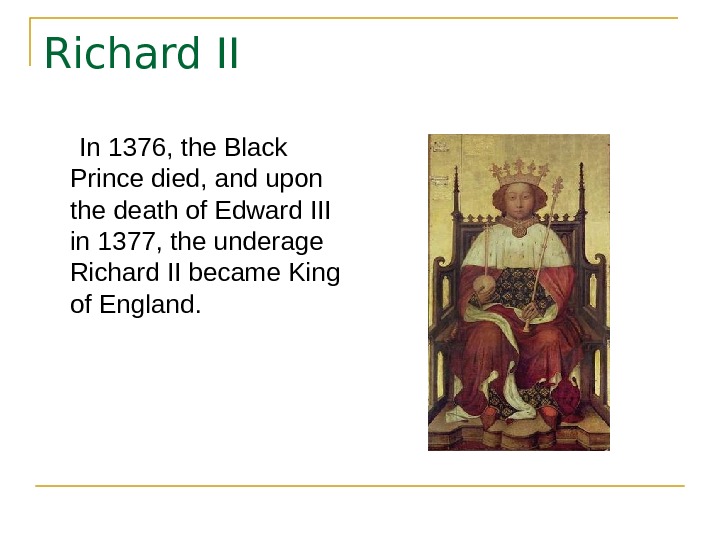
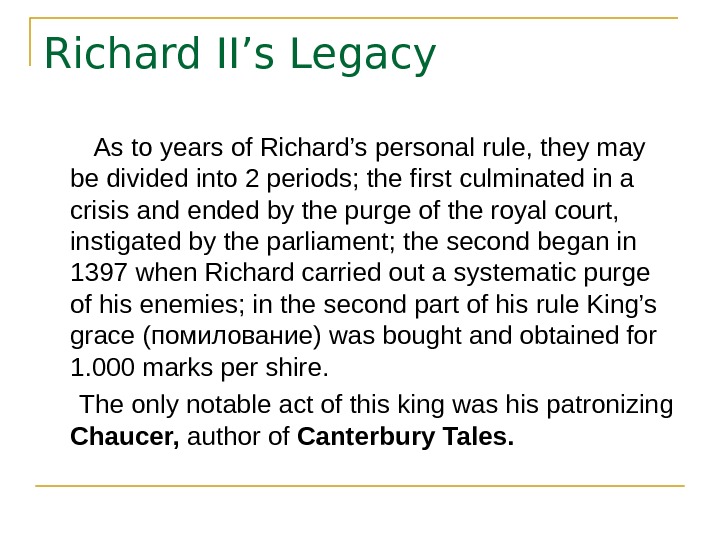
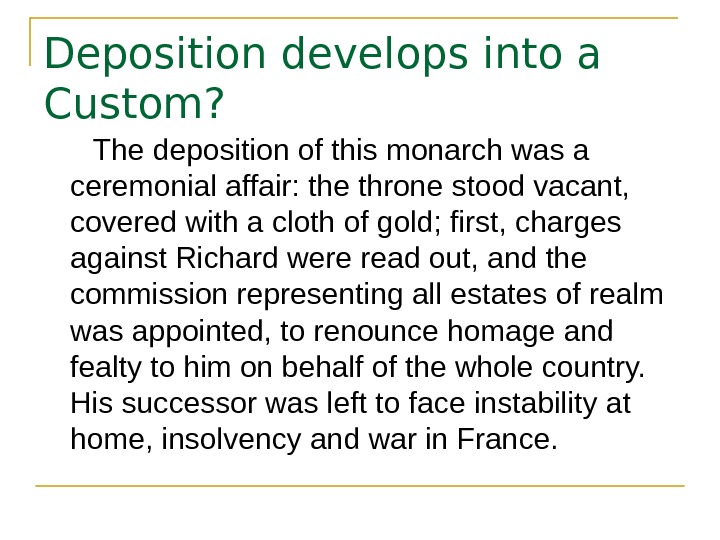
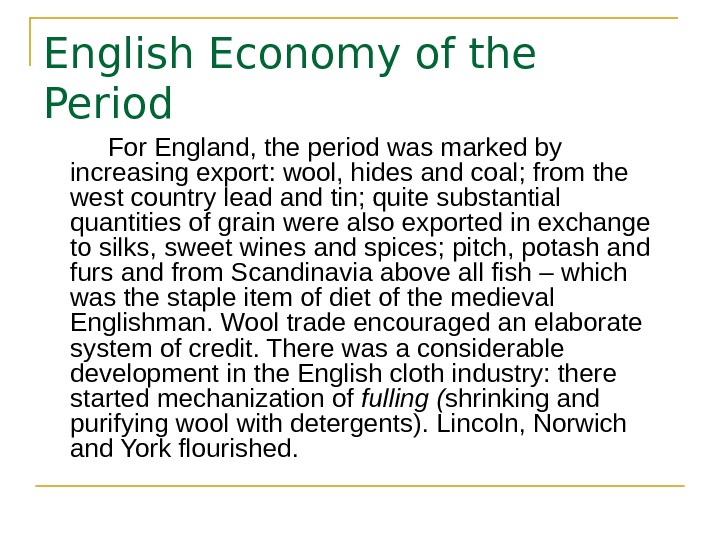



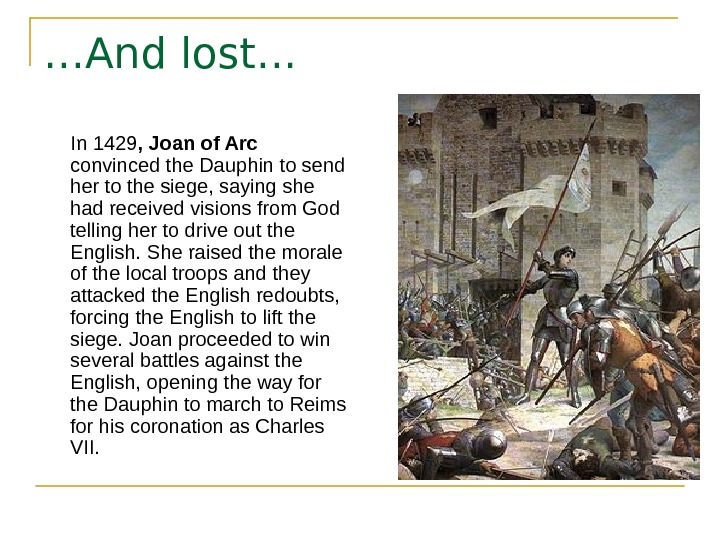
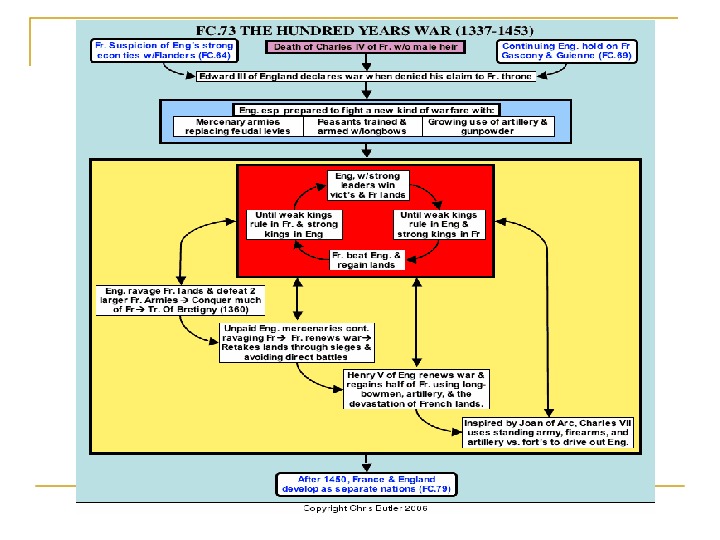
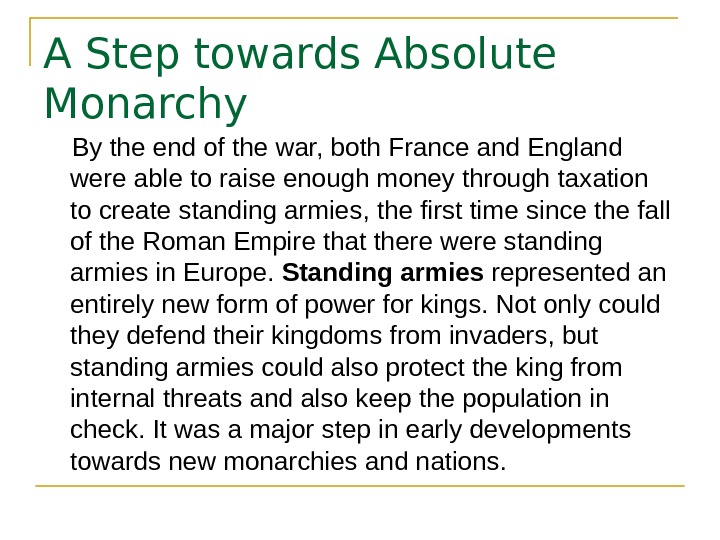

- Размер: 1 Mегабайта
- Количество слайдов: 39
Описание презентации Plantagenet England Plantagenet period is often used as по слайдам
 Plantagenet England Plantagenet period is often used as synonym for Later Middle Ages in Britain: the period of growing cities, trade and commerce. In this case its beginning roughly coincides with the reign of Edward I, the fourth Plantagenet in line.
Plantagenet England Plantagenet period is often used as synonym for Later Middle Ages in Britain: the period of growing cities, trade and commerce. In this case its beginning roughly coincides with the reign of Edward I, the fourth Plantagenet in line.
 What Shaped Political Landscape? During the period of later feudalism royal government was dictated by 2 essential weaknesses: the financial inadequacy of the crown’s resources and the fact that the king’s greater subjects were too powerful for him to manage on authority alone. In times of war the king inevitably looked to his subjects for grants of taxation, and bargained for that through accredited representatives – usually in Parliament; subsidies took time to collect, ant it was normal to ask for loans in anticipation of their payment; this often resulted in insolvency of the crown. Stability and authority of the government heavily depended on military success; the focal points in political disputes were the limits if royal prerogative power and the right of his subjects (in extreme circumstances) to resist the king’s government.
What Shaped Political Landscape? During the period of later feudalism royal government was dictated by 2 essential weaknesses: the financial inadequacy of the crown’s resources and the fact that the king’s greater subjects were too powerful for him to manage on authority alone. In times of war the king inevitably looked to his subjects for grants of taxation, and bargained for that through accredited representatives – usually in Parliament; subsidies took time to collect, ant it was normal to ask for loans in anticipation of their payment; this often resulted in insolvency of the crown. Stability and authority of the government heavily depended on military success; the focal points in political disputes were the limits if royal prerogative power and the right of his subjects (in extreme circumstances) to resist the king’s government.
 Edward I to some extent shaped the political landscape of the era. He reigned from 1272 to 1307. One of Edward’s early achievements was the conquest of Wales
Edward I to some extent shaped the political landscape of the era. He reigned from 1272 to 1307. One of Edward’s early achievements was the conquest of Wales
 ‘ Prince of Wales’ – origin. To consolidate his conquest, he commenced the construction of a string of massive stone castles encircling the principality, of which Caernarfon Castle provides a notable surviving example. Wales became incorporated into England under the Statute of Rhuddlan in 1284 and in 1301 Edward created his eldest son Edward Prince of Wales, since which time the eldest son of each English monarch has borne the same title.
‘ Prince of Wales’ – origin. To consolidate his conquest, he commenced the construction of a string of massive stone castles encircling the principality, of which Caernarfon Castle provides a notable surviving example. Wales became incorporated into England under the Statute of Rhuddlan in 1284 and in 1301 Edward created his eldest son Edward Prince of Wales, since which time the eldest son of each English monarch has borne the same title.
 Edward’s Legacy Edward I is also remembered for his governmental reforms, and especially the evolution of Parliament. Originally, this was any meeting of the king and his vassals or subjects to talk ( parley ), usually over taxes. Since negotiating taxes with each town and shire was cumbersome, Edward called the Model Parliament in 1295. This body consisted of representatives from all three estates. Although later parliaments did not necessarily contain all these elements, in time it came to be the rule that all three estates should be represented.
Edward’s Legacy Edward I is also remembered for his governmental reforms, and especially the evolution of Parliament. Originally, this was any meeting of the king and his vassals or subjects to talk ( parley ), usually over taxes. Since negotiating taxes with each town and shire was cumbersome, Edward called the Model Parliament in 1295. This body consisted of representatives from all three estates. Although later parliaments did not necessarily contain all these elements, in time it came to be the rule that all three estates should be represented.
 Scotland attacked and … Edward then turned his attentions to Scotland on May 10, 1291 Scottish nobles recognized the authority of Edward I. The Stone of Destiny was removed from Scone Palace and taken to Westminster Abbey. Until 1996, it formed the seat on King Edward’s Chair, on which all English monarchs since 1308 have been crowned, with the exception of Mary I. In 1996, the stone was returned to Scotland, to return only during royal coronations. His plan to unite the two countries never came to fruition during his lifetime.
Scotland attacked and … Edward then turned his attentions to Scotland on May 10, 1291 Scottish nobles recognized the authority of Edward I. The Stone of Destiny was removed from Scone Palace and taken to Westminster Abbey. Until 1996, it formed the seat on King Edward’s Chair, on which all English monarchs since 1308 have been crowned, with the exception of Mary I. In 1996, the stone was returned to Scotland, to return only during royal coronations. His plan to unite the two countries never came to fruition during his lifetime.
 Tower Edward was largely responsible for the Tower of London in the form we see today, including notably the concentric defenses, elaborate entranceways, and the Traitor’s Gate.
Tower Edward was largely responsible for the Tower of London in the form we see today, including notably the concentric defenses, elaborate entranceways, and the Traitor’s Gate.

 Edward II was lacking in drive and ambition and was «the first king after the Conquest who was not a man of business». His main interest was in entertainment, though he also took pleasure in athletics and in the practice of mechanical crafts. He had been so dominated by his father that he had little confidence in himself, and was always in the hands of some favourite with a stronger will than his own.
Edward II was lacking in drive and ambition and was «the first king after the Conquest who was not a man of business». His main interest was in entertainment, though he also took pleasure in athletics and in the practice of mechanical crafts. He had been so dominated by his father that he had little confidence in himself, and was always in the hands of some favourite with a stronger will than his own.
 Scotland lost again On June 24, 1314 , Edward’s ill-disciplined and badly led force was completely defeated by Bruce at the Battle of Bannockburn. Henceforth Bruce was sure of his position as King of Scots, and took vengeance for Edward I’s activities by devastating the northern counties of England.
Scotland lost again On June 24, 1314 , Edward’s ill-disciplined and badly led force was completely defeated by Bruce at the Battle of Bannockburn. Henceforth Bruce was sure of his position as King of Scots, and took vengeance for Edward I’s activities by devastating the northern counties of England.
 Trial of Regicide? The baroncy finally agreed on deposition ( низложение ) The Articles of Deposition accused Edward of many offences including: being incompetent to govern, unwilling to heed good counsel, allowing himself to be controlled by evil councilors, giving himself up to unseemly works and occupations, and plundering the kingdom. He was deposed by a unanimous consent of magnates, clergy and people and murdered in Berkley castle. Deposition itself, however, was a legal act and set a legal precedent.
Trial of Regicide? The baroncy finally agreed on deposition ( низложение ) The Articles of Deposition accused Edward of many offences including: being incompetent to govern, unwilling to heed good counsel, allowing himself to be controlled by evil councilors, giving himself up to unseemly works and occupations, and plundering the kingdom. He was deposed by a unanimous consent of magnates, clergy and people and murdered in Berkley castle. Deposition itself, however, was a legal act and set a legal precedent.
 Edward II’ Legacy The result of Edward II’ reign was loss of livestock, burning of homesteads which ruined agricultural property in the North. Lords of the border were left to defend themselves; the few who managed emerged the most powerful, military magnates, disrespectful of royal authority.
Edward II’ Legacy The result of Edward II’ reign was loss of livestock, burning of homesteads which ruined agricultural property in the North. Lords of the border were left to defend themselves; the few who managed emerged the most powerful, military magnates, disrespectful of royal authority.
 Edward III In the Statute of York parliament was clearly recognized as the body representing the whole community of the realm; parliaments started to deal with judicial business. Commons consolidated. After 1327 until at least 1470 the greatest changes came about not in consequence of the King’s wishes but in response to pressures.
Edward III In the Statute of York parliament was clearly recognized as the body representing the whole community of the realm; parliaments started to deal with judicial business. Commons consolidated. After 1327 until at least 1470 the greatest changes came about not in consequence of the King’s wishes but in response to pressures.
 Hundred Years’ War Edward III of England’s claimed the French throne when the childless Charles IV died. Edward was Charles’ nephew, while the next closest male claimant to the throne was a cousin, named Philip. However, the French did not want an Englishman on the French throne, and thereby chose Philip VI as their king. Edward, feeling slighted by this decision and being concerned about his hold on Gascony and Guienne, decided to fight for the throne. The Hundred Years War was on.
Hundred Years’ War Edward III of England’s claimed the French throne when the childless Charles IV died. Edward was Charles’ nephew, while the next closest male claimant to the throne was a cousin, named Philip. However, the French did not want an Englishman on the French throne, and thereby chose Philip VI as their king. Edward, feeling slighted by this decision and being concerned about his hold on Gascony and Guienne, decided to fight for the throne. The Hundred Years War was on.
 Territories Claimed
Territories Claimed
 The Bladestorm… The Hundred Years’ War is the name modern historians have given to what was actually a series of related conflicts, fought over a 116 -year period, between the England France, and later Burgundy; beginning in 1337, and ending in 1453. Historians group these conflicts under the same label, for convenience. The war was primarily fought in France; and though in retrospect, it has the feeling of a French civil war as much as an international conflict.
The Bladestorm… The Hundred Years’ War is the name modern historians have given to what was actually a series of related conflicts, fought over a 116 -year period, between the England France, and later Burgundy; beginning in 1337, and ending in 1453. Historians group these conflicts under the same label, for convenience. The war was primarily fought in France; and though in retrospect, it has the feeling of a French civil war as much as an international conflict.
 Phases of the War The war can be divided loosely into four phases: a phase of English success under Edward III from 1337 to 1360; a phase from 1360 to 1400, where the French were successful in nearly driving out the English; a phase from 1400 to 1429, marked by great English victories under Henry V; and a final phase from 1429 to 1453, in which France was united under the Valois kings. When the war began, France had a population of 14 million, and was generally recognized as having the largest number and best trained knights in Europe; England had a population of only two million.
Phases of the War The war can be divided loosely into four phases: a phase of English success under Edward III from 1337 to 1360; a phase from 1360 to 1400, where the French were successful in nearly driving out the English; a phase from 1400 to 1429, marked by great English victories under Henry V; and a final phase from 1429 to 1453, in which France was united under the Valois kings. When the war began, France had a population of 14 million, and was generally recognized as having the largest number and best trained knights in Europe; England had a population of only two million.
 Character of the War: Ferocity…
Character of the War: Ferocity…
 Battle of Crecy In July 1346, Edward mounted a major invasion across the Channel, landing in the Cotentin peninsula of Normandy, and marching through Normandy. Philip gathered a large army to oppose him, and Edward chose to march northward toward the Low Countries, pillaging as he went, rather than attempt to take and hold territory. Finding himself unable to outmaneuver Philip, Edward positioned his forces for battle, and Philip’s army attacked him at the famous Battle of Crecy. The much larger French army made a series of piecemeal attacks against the expert English and Welsh longbow men, and all of the attacks were dispersed with heavy losses until the French were forced to retreat. Crecy was a crushing defeat for the French.
Battle of Crecy In July 1346, Edward mounted a major invasion across the Channel, landing in the Cotentin peninsula of Normandy, and marching through Normandy. Philip gathered a large army to oppose him, and Edward chose to march northward toward the Low Countries, pillaging as he went, rather than attempt to take and hold territory. Finding himself unable to outmaneuver Philip, Edward positioned his forces for battle, and Philip’s army attacked him at the famous Battle of Crecy. The much larger French army made a series of piecemeal attacks against the expert English and Welsh longbow men, and all of the attacks were dispersed with heavy losses until the French were forced to retreat. Crecy was a crushing defeat for the French.
 Longbows
Longbows
 Black Death Year The year 1348 went down in history as The Black Death Year , which changed the economic situation in the country. After the great pandemic of bubonic plague reached England, 1/3 of population may have perished. Scarcity of labor and the sharp consequent rise of wages led directly to the first major attempt of the English government to freeze prices and wages; this statute was doomed to failure; mobility of laborers increased; it ceased to be possible for landlords to restrain dissatisfied men from leaving home.
Black Death Year The year 1348 went down in history as The Black Death Year , which changed the economic situation in the country. After the great pandemic of bubonic plague reached England, 1/3 of population may have perished. Scarcity of labor and the sharp consequent rise of wages led directly to the first major attempt of the English government to freeze prices and wages; this statute was doomed to failure; mobility of laborers increased; it ceased to be possible for landlords to restrain dissatisfied men from leaving home.
 Plague coming to Europe…
Plague coming to Europe…

 Battle of Poitiers , After the Black Death had passed and England was able to recover financially, Edward’s son, Edward the Black Prince, invaded France from Gascony in 1356, winning a great victory in the Battle of Poitiers , where the English archers repeated the same tactics used at Crecy, and succeeded in capturing the new Valois king, John II of France, and many of his nobles. John signed a truce with Edward, and in his absence much of the government began to collapse. John’s ransom was set to two million, but John believed he was worth more than that and insisted that his ransom be raised to four million.
Battle of Poitiers , After the Black Death had passed and England was able to recover financially, Edward’s son, Edward the Black Prince, invaded France from Gascony in 1356, winning a great victory in the Battle of Poitiers , where the English archers repeated the same tactics used at Crecy, and succeeded in capturing the new Valois king, John II of France, and many of his nobles. John signed a truce with Edward, and in his absence much of the government began to collapse. John’s ransom was set to two million, but John believed he was worth more than that and insisted that his ransom be raised to four million.
 Tourneys and Code of Gallantry
Tourneys and Code of Gallantry
 Peasant Revolts Two revolts typified peasant uprisings, one in France and one in England. The Jacquerie, named after the popular name for French peasants, broke out in 1358, ten years after the Black and in the midst of the Hundred Years War with its destruction, high taxes, and forced labor to repair fortifications. On May 28, about 100 peasants in the village of St. Leu assaulted the nearest manor house and massacred the lord and his family. From there, the revolt spread quickly across the countryside with the usual atrocities and a reported 160 castles burned. Many towns, either out of sympathy or fear of the peasants, opened their gates to them.
Peasant Revolts Two revolts typified peasant uprisings, one in France and one in England. The Jacquerie, named after the popular name for French peasants, broke out in 1358, ten years after the Black and in the midst of the Hundred Years War with its destruction, high taxes, and forced labor to repair fortifications. On May 28, about 100 peasants in the village of St. Leu assaulted the nearest manor house and massacred the lord and his family. From there, the revolt spread quickly across the countryside with the usual atrocities and a reported 160 castles burned. Many towns, either out of sympathy or fear of the peasants, opened their gates to them.
 … always crushed
… always crushed
 Wat Tyler The Wat Tyler rebellion broke out in England in 1381. The immediate causes were much the same as those of the Jacquerie: high war taxes, a recent outbreak of plague, and a resulting agricultural crisis. The course of events was also similar. The rebels advanced all the way to London, looting and pillaging as they came. They even managed to seize and murder several of the king’s officials. However, a daring ride in front of the rebels by the boy king, Richard II, who offered them concessions and supposedly his leadership in the revolt, settled them down. A parley was then arranged with the peasants’ leader, Wat Tyler, which ended in his murder.
Wat Tyler The Wat Tyler rebellion broke out in England in 1381. The immediate causes were much the same as those of the Jacquerie: high war taxes, a recent outbreak of plague, and a resulting agricultural crisis. The course of events was also similar. The rebels advanced all the way to London, looting and pillaging as they came. They even managed to seize and murder several of the king’s officials. However, a daring ride in front of the rebels by the boy king, Richard II, who offered them concessions and supposedly his leadership in the revolt, settled them down. A parley was then arranged with the peasants’ leader, Wat Tyler, which ended in his murder.
 Richard II In 1376, the Black Prince died, and upon the death of Edward III in 1377, the underage Richard II became King of England.
Richard II In 1376, the Black Prince died, and upon the death of Edward III in 1377, the underage Richard II became King of England.
 Richard II’s Legacy As to years of Richard’s personal rule, they may be divided into 2 periods; the first culminated in a crisis and ended by the purge of the royal court, instigated by the parliament; the second began in 1397 when Richard carried out a systematic purge of his enemies; in the second part of his rule King’s grace ( помилование ) was bought and obtained for 1. 000 marks per shire. The only notable act of this king was his patronizing Chaucer, author of Canterbury Tales.
Richard II’s Legacy As to years of Richard’s personal rule, they may be divided into 2 periods; the first culminated in a crisis and ended by the purge of the royal court, instigated by the parliament; the second began in 1397 when Richard carried out a systematic purge of his enemies; in the second part of his rule King’s grace ( помилование ) was bought and obtained for 1. 000 marks per shire. The only notable act of this king was his patronizing Chaucer, author of Canterbury Tales.
 Deposition develops into a Custom? The deposition of this monarch was a ceremonial affair: the throne stood vacant, covered with a cloth of gold; first, charges against Richard were read out, and the commission representing all estates of realm was appointed, to renounce homage and fealty to him on behalf of the whole country. His successor was left to face instability at home, insolvency and war in France.
Deposition develops into a Custom? The deposition of this monarch was a ceremonial affair: the throne stood vacant, covered with a cloth of gold; first, charges against Richard were read out, and the commission representing all estates of realm was appointed, to renounce homage and fealty to him on behalf of the whole country. His successor was left to face instability at home, insolvency and war in France.
 English Economy of the Period For England, the period was marked by increasing export: wool, hides and coal; from the west country lead and tin; quite substantial quantities of grain were also exported in exchange to silks, sweet wines and spices; pitch, potash and furs and from Scandinavia above all fish – which was the staple item of diet of the medieval Englishman. Wool trade encouraged an elaborate system of credit. There was a considerable development in the English cloth industry: there started mechanization of fulling ( shrinking and purifying wool with detergents). Lincoln, Norwich and York flourished.
English Economy of the Period For England, the period was marked by increasing export: wool, hides and coal; from the west country lead and tin; quite substantial quantities of grain were also exported in exchange to silks, sweet wines and spices; pitch, potash and furs and from Scandinavia above all fish – which was the staple item of diet of the medieval Englishman. Wool trade encouraged an elaborate system of credit. There was a considerable development in the English cloth industry: there started mechanization of fulling ( shrinking and purifying wool with detergents). Lincoln, Norwich and York flourished.
 Urbanization? There were 3000 grants of a market issued in the XIV century in England (the grant of a market turned the settlement into a town). Creation of guilds increased the quality of produce. Tillable land was in demand; there already existed 2 or 3 field system; the predominant role of landlord changed from that of a farmer to that of a renter.
Urbanization? There were 3000 grants of a market issued in the XIV century in England (the grant of a market turned the settlement into a town). Creation of guilds increased the quality of produce. Tillable land was in demand; there already existed 2 or 3 field system; the predominant role of landlord changed from that of a farmer to that of a renter.
 Henry V The new English king, Henry V, upon accession had to deal with three main problems: the restoration of domestic peace, the healing of schism in the Church and the recovery of English prestige in Europe. Henry V’ aims in some respects anticipated those of his Tudor successors (as did his modeling himself on King Arthur — Henry VII’s eldest son was, of course, named Arthur), but he would have accomplished them on medieval lines as a constitutional ruler. His success was due to the power of his personality. He could train able lieutenants, but at his death there was no one who could take his place as leader. War, diplomacy and civil administration were all dependent on his guidance. If he was not the founder of the English navy he was one of the first to realize its true importance. Almost two hundred years after death, Henry became the subject of a famous play by William Shakespeare — Henry V.
Henry V The new English king, Henry V, upon accession had to deal with three main problems: the restoration of domestic peace, the healing of schism in the Church and the recovery of English prestige in Europe. Henry V’ aims in some respects anticipated those of his Tudor successors (as did his modeling himself on King Arthur — Henry VII’s eldest son was, of course, named Arthur), but he would have accomplished them on medieval lines as a constitutional ruler. His success was due to the power of his personality. He could train able lieutenants, but at his death there was no one who could take his place as leader. War, diplomacy and civil administration were all dependent on his guidance. If he was not the founder of the English navy he was one of the first to realize its true importance. Almost two hundred years after death, Henry became the subject of a famous play by William Shakespeare — Henry V.
 France Conquered…? Henry took much of Normandy, including Caen in 1417 and Rouen on January 19, 1419, placing Normandy under English rule after over 200 years of French control. He made formal alliance with the Burgundians, who had taken Paris, after the Armagnac execution of John of Burgundy in 1419. In 1420, Henry met with the mad king Charles VI, who signed the Treaty of Troyes , by which Henry would marry Charles’ daughter Catherine of Valois and Henry’s heirs would inherit the throne of France.
France Conquered…? Henry took much of Normandy, including Caen in 1417 and Rouen on January 19, 1419, placing Normandy under English rule after over 200 years of French control. He made formal alliance with the Burgundians, who had taken Paris, after the Armagnac execution of John of Burgundy in 1419. In 1420, Henry met with the mad king Charles VI, who signed the Treaty of Troyes , by which Henry would marry Charles’ daughter Catherine of Valois and Henry’s heirs would inherit the throne of France.
 … And lost… In 1429 , Joan of Arc convinced the Dauphin to send her to the siege, saying she had received visions from God telling her to drive out the English. She raised the morale of the local troops and they attacked the English redoubts, forcing the English to lift the siege. Joan proceeded to win several battles against the English, opening the way for the Dauphin to march to Reims for his coronation as Charles VII.
… And lost… In 1429 , Joan of Arc convinced the Dauphin to send her to the siege, saying she had received visions from God telling her to drive out the English. She raised the morale of the local troops and they attacked the English redoubts, forcing the English to lift the siege. Joan proceeded to win several battles against the English, opening the way for the Dauphin to march to Reims for his coronation as Charles VII.

 A Step towards Absolute Monarchy By the end of the war, both France and England were able to raise enough money through taxation to create standing armies, the first time since the fall of the Roman Empire that there were standing armies in Europe. Standing armies represented an entirely new form of power for kings. Not only could they defend their kingdoms from invaders, but standing armies could also protect the king from internal threats and also keep the population in check. It was a major step in early developments towards new monarchies and nations.
A Step towards Absolute Monarchy By the end of the war, both France and England were able to raise enough money through taxation to create standing armies, the first time since the fall of the Roman Empire that there were standing armies in Europe. Standing armies represented an entirely new form of power for kings. Not only could they defend their kingdoms from invaders, but standing armies could also protect the king from internal threats and also keep the population in check. It was a major step in early developments towards new monarchies and nations.
 Thank you for your Attention!
Thank you for your Attention!

